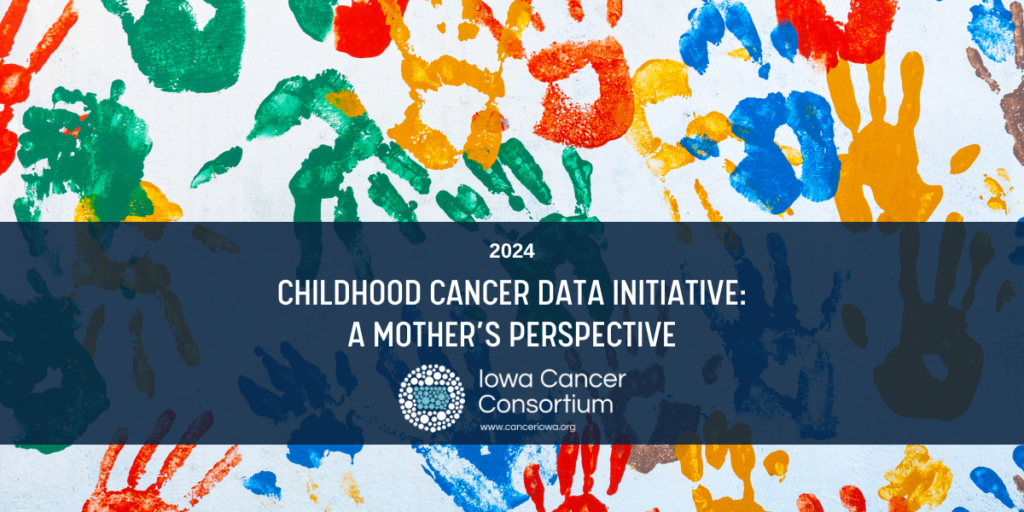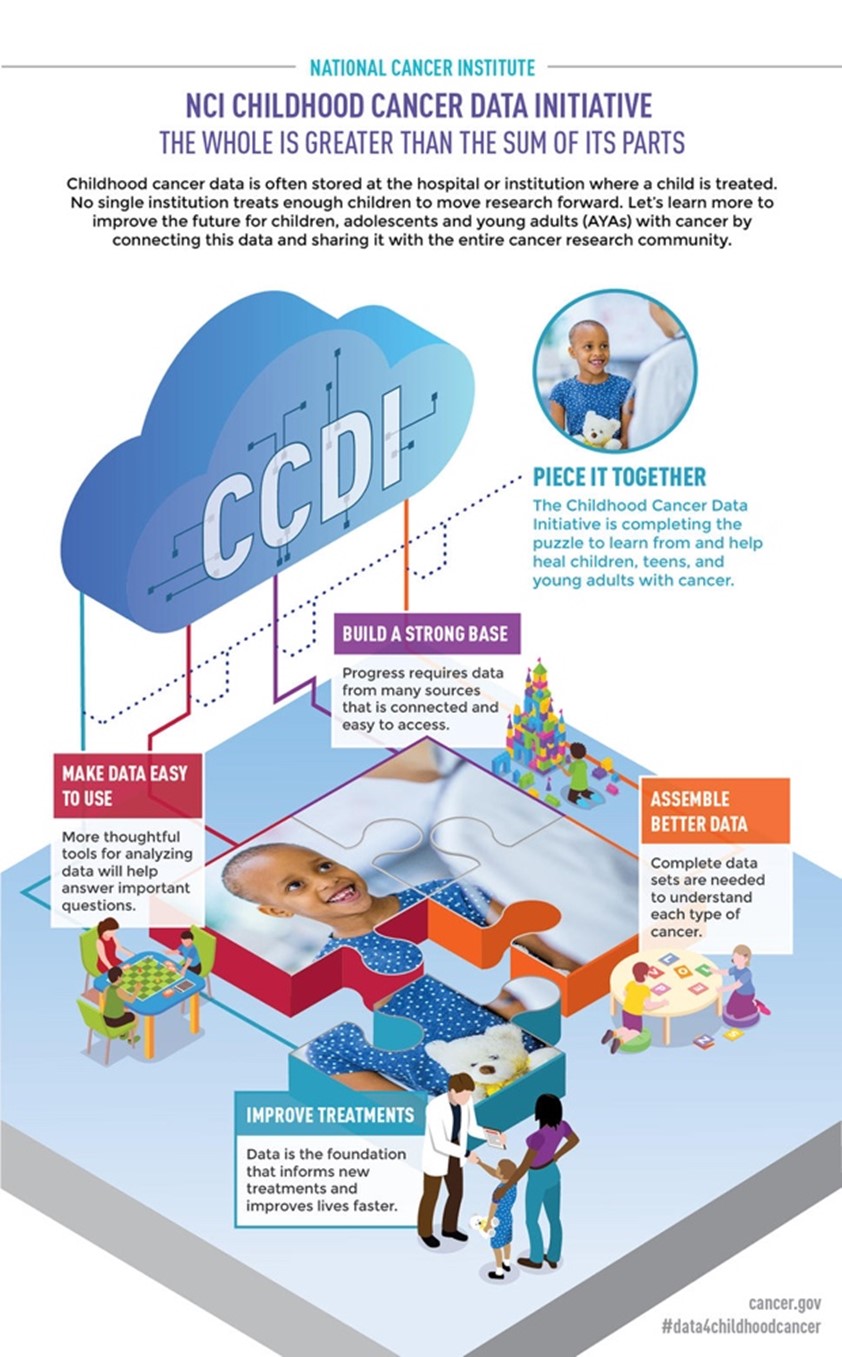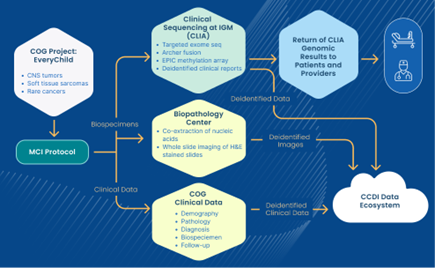Childhood Cancer Data Initiative: A Mother’s Perspective

By Natalie Steuer
Childhood cancer is a complex issue impacting many families in Iowa. While great progress has been made in treating children with cancer nationally, the research momentum has been limited for many forms of childhood cancer. In the 1970’s, just over 50% of children diagnosed with cancer could expect to survive 5 years or longer. But advances in treatment have raised that figure to higher than 80% today. And yet despite these positive improvements in treatment outcomes, the specific causes of most pediatric cancers and long-term effects from cancer treatment remain largely unknown.
“Even one child dying from cancer is one child too many. Clearly, there is much more we must do to address the challenges that have hindered more rapid progress.”
– Douglas R. Lowry, MD | Past Acting Director, National Cancer Institute
A Call to Action
In order to make new discoveries and accelerate medical advances, childhood cancer data needs to be more readily accessible outside of where a child, adolescent, or young adult (AYA) is treated. In 2019, the National Cancer Institute (NCI) launched the Childhood Cancer Data Initiative (CCDI), which aims to build a community of pediatric cancer researchers, advocates, families, hospitals, and networks who are committed to sharing data with one another to improve treatments, quality of life, and survivorship of every child with cancer (source).
The main goals of CCDI include:
- Gather data from every child, adolescent, and young adult (AYA) diagnosed with a childhood cancer, regardless of where they receive their care.
- Create a national strategy of using molecular characterization to speed diagnosis and inform treatment for all types of childhood cancers.
- Develop a platform and tools to bring together clinical care and research data that will improve prevention measures, treatment, quality of life, and survivorship for childhood cancers.
Progress
The CCDI is an incredibly valuable tool in the world of childhood cancer. Within the Initiative there are a lot of moving parts. Here are a few of them:
Data Infrastructure
To start, it’s crucial to build a solid data infrastructure, so CCDI created a data “ecosystem” which will house all this data. It might seem like a simple task for oncologists and researchers at different health systems to share their data in the same place. However, the reality is far from that. Think of every health system’s data as being housed on a different “cloud” in the sky. Multiple “clouds” have been created, resulting in data shuffling all over the place. This can make it incredibly challenging for healthcare providers to give the best treatment for these rare cancers because they don’t have access to data on similar cases. Therefore, the CCDI “ecosystem”, acting like the sun, gathers data from all the “clouds,” creating a hub for all pediatric oncologists to access precise data for the specific cancer they specialize in.

Molecular Characterization Initiative
To continue our weather metaphor, under the CCDI umbrella sits the Molecular Characterization Initiative (MCI). According to the National Cancer Institute, molecular characterization involves looking at the DNA and RNA of the tumor or blood cells to better understand its makeup, causes, and possible treatment. MCI is a national collaboration between the Children’s Oncology Group, advocates, pediatric oncologists, researchers, data scientists, patients, and families that provides free molecular characterization to help participants and doctors select the best treatment options.

Molecular Targets Platform
The Molecular Targets Platform is an NCI-supported database for preclinical pediatric oncology data. It is a tool that helps identify relationships between molecular characterization and disease types, and in turn helps identify the best drug treatment options based on the data. Once in the platform, you can search based on your child’s identified gene or disease type and review the data with your provider.
Childhood Cancer Data Catalog
Finally, the Childhood Cancer Data Catalog offers many resources, including genomic sequencing and therapeutic efficacy data. Caregivers can explore the CCDC and should consulting with their provider for clarification or guidance.

Childhood cancer is complex and difficult, and it can be challenging for caregivers to navigate and understand. It is important to highlight several crucial elements under the CCDI umbrella that can help increase the chances of successful treatment. By providing caregivers with the appropriate resources and education, they can better care for their child and improve their outcomes. The availability of these tools can make a significant difference in the lives of childhood cancer patients and their families!
Stay up-to-date on CCDI: To learn more, sign up to receive email updates on the progress of CCDI.
About the Author
Natalie Steuer has been a dedicated advocate for childhood cancer ever since her son was diagnosed with an aggressive form of cancer at age 3. He was treated at the University of Iowa Stead Family Children’s Hospital, and the Childhood Cancer Data Initiative was critical in his treatment. He needed genomic testing, which helped determine which chemotherapies would be most effective. Parents and caregivers play a vital role in their child’s cancer treatment, and Natalie encourages everyone to empower themselves with information.
